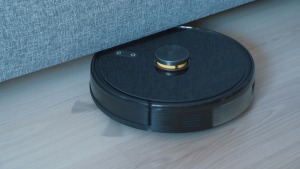


Blogs I published 13 June 2024 I Dirk Hoogenboom
7 Smart Home Trends To Watch for in 2024
Suffice it to say that digital integration is embedded in the way we live. From smartphones to social media, from finance to fitness, breakthroughs in tech are constantly weaved into our daily routines. Seemingly a blueprint from the future, smart homes are an extension of our desire for convenience, with growing capabilities that allow homeowners to transform their living spaces into responsive environments that fully cater to their needs.
Automated appliances, advanced security systems, health monitoring and other tech-powered amenities may seem like a Jetsons-type fantasy, but the truth is – smart homes are rapidly becoming our reality. Transforming our day-to-day by personalizing comfort, innovations in home-making are less about the wow-factor and more about making our lives easier through effortless control.
So if you’re looking for ways to improve your surroundings, and free up your time for activities you actually enjoy, let’s go over the top smart home trends you might want to keep an eye on in 2024.
Prioritizing Sustainability
Remember coming home, only to realize you’ve left the lights on? Or a gut feeling telling you the sprinklers needed adjusting before a vacation? Or any of a hundred similar nuisances that run up both stress and wasted energy? With smart homes going green, contributing to eco-friendly efforts is easier than ever.
Innovative features ranging from smart lighting systems to energy-efficient appliances and water conservation can change your living spaces from disorganized consumers to sustainable havens. If you’re looking to reduce your environmental impact, look into smart thermostats that automatically regulate temperature based on occupancy, power strips that cut power to inactive devices, lighting systems that kick on only when you need them to, water heaters that adjust to your patterns, appliances with energy-saving features, intuitive window upgrades, solar integration or sustainable building materials. Promote an efficient and laid-back lifestyle by incorporating these upgrades into your home.
Granted, this can’t be done overnight and doesn’t come cheap. But it shouldn’t discourage you as these features can be implemented gradually, starting with affordable and easy-to-use options and slowly moving on to more demanding improvements. In the long run, investing in low-impact, eco-friendly smart homes is good for both the planet and your wallet; the initial cost can be recouped over time through significant reductions in your energy bills.


Health monitoring
Modern lifestyles find us focusing more and more on health and well-being. For a long time, living spaces weren’t part of the equation; it was more about fitness trackers, nutrition reels and mindfulness apps. Smart homes, however, are becoming a reliable and proactive partner in our health journey, offering features that empower us to take charge of our well-being. Your humble living room can turn into a fully-functioning monitoring hub. How?
Think smart mattresses tracking your sleep quality, heart rate and respiration so you know why some mornings feel off. Think smart scales that measure your weight, body fat percentage and muscle mass composition, meaning accurate stats at home. Think home systems that tailor workout plans based on the data from wearable tech. For those with chronic health conditions, medication dispensers that dispense medication at set times or blood pressure monitors that alert you of potential concerns could prove invaluable. Air quality monitors, thermometers or lighting systems that mimic natural cycles all promote a healthier and more comfortable living environment. Manage your well-being from the comfort of your own home.
Voice and Gesture Control
The concept of a smart home may excite many, but constantly interacting with apps, touchscreens and sensors might not be ideal for everyone. Luckily for those looking for a handsfree way to navigate their home, options for interaction are available. Voice and gesture controls are stepping into the spotlight, providing an even wider range of control.
It’s as simple as programming a word to trigger the lights, adjust the temperature or draw the curtains for a quick nap without fumbling with buttons. Using voice commands to activate complex routines offers a level of control and customization that traditional methods can’t match. Gesture control, on the other hand, takes it a step further – pointing to a device to turn it on, swiping to adjust volume or a good old clap to turn the lights off. For individuals with limited mobility, a simple wave can close the blinds or adjust the thermostat while a head tilt will pause a movie. This empowers them to live more independently and comfortably within their smart homes.
Word to the wise. As revolutionary as they may be, there’s still room for improvement: background noise can impact voice commands while complex gestures might not be interpreted correctly. Voice assistants require access to user data so get to know privacy policies and manage your data preferences for a smooth and safe integration.


Advanced Security Systems
A sturdy door and a barking dog are time-tested recipes for home security but today they simply won’t do. Be it a weekend getaway or a long day at work, homeowners know that leaving their home or tucking in at night comes with a distinct feeling of vulnerability. So knowing you’re safe from break-ins, emergencies or any other worries is, really, just a sound table stake. That’s where smart security systems come in, offering a multi-layered approach to safeguarding your home.
Keeping a watchful eye on your premises while you’re away, detecting potential problems before they escalate or offering remote control capabilities, security systems nowadays are optimized to see inside and out, putting you in charge of your home’s security no matter where you are. Stressing over unlocked doors, smoke alarms or unwanted guests? Smart sensors will let you know if there’s anything to worry about, in real-time. An appliance was left running and you can’t get to it – a program will check its status and switch it off for you. Lights were triggered by motion at night? Cameras are in place, taking snapshots and recording. This proactive and responsive ecosystem ensures peace of mind.


Robotic Assistance
It started out with robotic vacuums, but the future of automation extends far beyond spotless floors and perfectly-brewed coffee. Sure, mowing the lawn, cleaning the gutter or dusting the house can be gratifying, but recent breakthroughs allow robots to take over when the weekend seems too short for busywork or, to be frank, when you just don’t feel like it.
The repetitive tasks that eat into our time are prime targets for robotic assistance, bringing a sense of ease and efficiency to your daily life. Whether it’s folding laundry, meal prep or mopping the floors, these robots can be customized to your needs and preferences, handling tasks you most dislike. Integrating these technologies can mean creating a seamless ecosystem that’s truly personalized and responsive to the current needs of your home.
As you explore these robotic solutions, it’s also worth considering broader home improvement industry trends that are shaping the future of living spaces.
As for the future, it’s headed in the proactive direction: robots that anticipate your needs and complete tasks without your prompts. Imagine them starting the dishwasher after dinner or preheating the oven as you’re on your way home while you kick back. However, the future of smart homes with robots isn’t just about automation; it’s about creating a space that empowers you to live your life to the fullest.
Autonomous Smart Appliances
Selecting the right washing machine cycle, cleaning the trash compactor or fiddling with oven temperatures is, more often than not, a hassle. No more. Smart appliances are becoming increasingly more autonomous, taking the wheel while you take care of the bigger picture.
Say you toss in a load of laundry in the machine and a smart washer, based on fabric-type and weight, takes care of the optimal cycle. Or your fridge knowing there’s produce wilting so it and recommends a recipe that uses them. These features have less to do with convenience and more with optimization and personalization. In essence, this is what the smart home truly is – a future where technology empowers you to live a more efficient, comfortable, and fulfilling life.


AI Personalization and Connectivity
Underlying all these trends is an intricate, and ever-expanding, network of interconnected systems. On the surface, it’s about controlling lights and playing music. However, looking on, the smart home is designed to think ahead by learning about your habits, preferences and routines. The more you interact with it, the more it learns and adapts, creating a truly personalized living environment.
Designed to be problem-solvers, these algorithms are trained to recognize patterns and adapt to your quirks. Say it’s a regular weekday – do you always turn on the lights and coffee maker at 7 am? When you come home, do you first water your garden or put on some music? What time does the dryer start? Do you prefer dim lighting when watching a movie or the shutters open while sleeping? You may not know, but your smart home can. And that, in a nutshell, is how connectivity empowers data, and data allows for personalization.

Read more

Fresh Insights Await
Our latest reports
Delve into the newest findings across various market segments, crafted for a cutting-edge overview. Explore our latest reports, brimming with up-to-date data, trend analyses, and in-depth examinations, all tailored to provide you with a comprehensive understanding of the current market dynamics.
Construction
Home Improvement
Installation
Special reports












